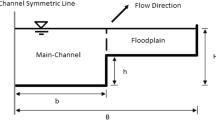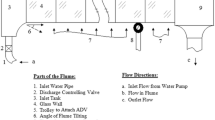Abstract
In this paper, an effort was made to model velocity and boundary shear stress distributions in a compound channel with skewed floodplains. A three-dimensional computational fluid dynamics model (CFD) was used to solve the time-averaged Navier–Stokes equations. Based on the k-ε turbulence model, the ANSYS-CFX software was used to evaluate the velocity, bed shear stress distributions, and secondary flow circulations in a skewed compound channel with skew angle of 5.1° and different overbank flow depths. The results of numerical modelling at two selected sections were then compared to the published experimental data. The study shows that the k-ε turbulence model is able to evaluate the flow field in the skewed compound channel fairly well. The numerical modelling also reveals the existence of the helical secondary flow with the horizontal axis in the main channel which created by the mass exchange between the converging floodplain and the main channel.
















Similar content being viewed by others
References
Bousmar D, Zech Y (1999) Momentum transfer for practical flow computation in compound channel. J Hydraul Eng 125(7):696–706. https://doi.org/10.1061/(ASCE)0733-9429(1999)125:7(696)
Bousmar D, Wilkin N, Jacquemart JH, Zech Y (2004) overbank flow in symmetrically narrowing floodplains. J Hydraul Eng 130(4):305–312. https://doi.org/10.1061/(ASCE)0733-9429(2004)130:4(305)
Celik IB, Ghia U, Roache PJ (2008) procedure for estimation and reporting of uncertainty due to discretization in CFD applications. J Fluids Eng 130(7):1–4. https://doi.org/10.1115/1.2960953
Chlebek J (2009) Modelling of simple prismatic channel with varying roughness using the SKM and a study of flows in smooth non-prismatic channels with skewed floodplain. Dissertation, University of Birmingham, Birmingham, UK.
Cokljat D, Younis BA (1995) Second-order closure study of open-channel flows. J Hydraul Eng 121(2):94–107. https://doi.org/10.1061/(ASCE)0733-9429(1995)121:2(94)
Elliott SCA (1990) An investigation into skew channel flow. Dissertation, University of Bristol, Bristol, UK.
Elliott SCA, Sellin RHJ (1990) SERC flood channel facility: skewed flow experiments. J Hydraul Res 28(2):197–214. https://doi.org/10.1080/00221689009499086
Filonovich M, Azevedo R, Rojas-Solorzano LR, Leal JB (2010) Simulation of the velocity field in compound channel flow using different closure models. Paper presented at 1st European IAHR Congress, Edinburgh, UK.
Fischer-Antze T, Stoesser T, Bates P, Olsen NRB (2001) 3D numerical modelling of open channel flow with submerged vegetation. J Hydraul Res 39(3):303–310. https://doi.org/10.1080/00221680109499833
James M, Brown BJ (1977) Geometric parameters that influence floodplain flow. Waterways experiment section hydraulics laboratory department of defense us army corps of engineering
Kang H, Choi SU (2005) 3D numerical simulation of compound open-channel flow with vegetated floodplains by reynolds stress model. KSCE J Civ Eng 9(1):7–11. https://doi.org/10.1007/BF02829092
Kara S, Stoesser T, Sturm TW (2012) Turbulence statistics in compound channels with deep and shallow overbank flows. J Hydraul Res 50(5):482–493. https://doi.org/10.1080/00221686.2012.724194
Keller RJ, Rodi W (1989) Prediction of flow characteristics in main channel/floodplain flows. J Hydraul Res 26(4):425–441. https://doi.org/10.1080/00221688909499131
Krishnappan BG, Lau YL (1986) Turbulence modeling of flood plain flows. J Hydraul Eng 112(4):251–266. https://doi.org/10.1061/(ASCE)0733-9429(1986)112:4(251)
Launder BE, Spalding DB (1974) The numerical computation of turbulent flows. Comput Methods Appl Mech Eng 3(2):269–289. https://doi.org/10.1016/0045-7825(74)90029-2
Naot D, Nezu I, Nakagawa H (1993) Hydrodynamic behavior of compound rectangular open channels. J Hydraul Eng 119(3):390–408. https://doi.org/10.1061/(ASCE)0733-9429(1993)119:3(390)
Naot D, Rodi W (1982) Calculation of secondary currents in channel flow. J Hydraul Div 108:948–968. https://doi.org/10.1061/JYCEAJ.0005897
Pezzinga G (1994) Velocity distribution in compound channel flows by numerical modelling. J Hydraul Eng 120(10):1176–1198. https://doi.org/10.1061/(ASCE)0733-9429(1994)120:10(1176)
Proust S, Rivière N, Bousmar D, Paquier A, Zech Y, Morel R (2006) Flow in compound channel with abrupt floodplain contraction. J Hydraul Eng 132(9):958–970. https://doi.org/10.1061/(ASCE)0733-9429(2006)132:9(958)
Rameshwaran P, Naden PS (2003) Three dimensional numerical simulation of compound channel flows. J Hydraul Eng 129(8):645–652. https://doi.org/10.1061/(ASCE)0733-9429(2003)129:8(645)
Rastogi AK, Rodi W (1978) Predictions of heat and mass transfer in open channels. J Hydraul Div 104(3):397–419. https://doi.org/10.1061/JYCEAJ.0004962
Rezaei B, Amiri H (2018) Numerical modelling of flow field in compound channels with non-prismatic floodplains. J Sci Irani 25(5):2413–2424. https://doi.org/10.24200/sci.2017.4215
Rezaei B, Knight DW (2011) Overbank flow in compound channels with non-prismatic floodplains. J Hydraul Eng 137(8):815–824. https://doi.org/10.1061/(ASCE)HY.1943-7900.0000368
Wright NG, Crossley AJ, Morvan HP, Stoesser T (2004) Detailed validation of CFD for flows in straight channels. Paper presented at River Flow 2004, Naples, Italy, pp.1041–1048.
Xie Z, Lin B, Falconer RA (2013) Large-eddy simulation of the turbulent structure in compound open-channel flows. Adv Water Resour 53:66–75. https://doi.org/10.1016/j.advwatres.2012.10.009
Author information
Authors and Affiliations
Corresponding author
Rights and permissions
About this article
Cite this article
Rezaei, B., Seif, M.M. Numerical Study of Flow in Skewed Compound Channel Using k-ε Turbulence Model. Iran J Sci Technol Trans Civ Eng 46, 3919–3929 (2022). https://doi.org/10.1007/s40996-022-00922-w
Received:
Accepted:
Published:
Issue Date:
DOI: https://doi.org/10.1007/s40996-022-00922-w




